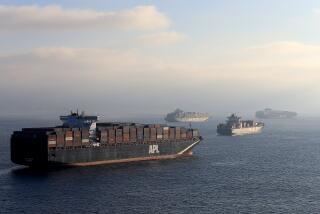Methane May Play Key Role in Global Warming : Geophysics: Scientist says release of the gas from undersea crystals could have helped heat atmosphere in distant past. : SCIENCE FILE: An exploration of issues and trends affecting science, medicine and the environment.
- Share via
SAN FRANCISCO — Methane from the sea floor may play a far more crucial role in global warming than had been previously believed, according to a UC Santa Barbara scientist.
Undersea methane might have been a critical trigger in a series of rapid warmings in the Earth’s past, said the scientist, James Kennett. If so, he said, the same mechanism could be activated by the current trend toward warmer temperatures that many believe will result in a greenhouse effect on Earth.
Speaking Wednesday at the fall meeting of the American Geophysical Union, Kennett, director of UC Santa Barbara’s Marine Science Institute, presented data indicating sharp rises in the amounts of methane near the start of two warming cycles, one about 44,000 years ago, the other 38,000 years ago.
Methane is one of the so-called greenhouse gases that trap heat in the atmosphere. The greenhouse effect is a warming of the Earth caused by the gases, which allow the sun’s light to penetrate to the planet’s surface while preventing heat from radiating into space.
“There hasn’t been sufficient attention to the role of methane for the rapid release of greenhouse gases,” Kennett said. Huge reservoirs of frozen methane crystals called clathrates lie trapped in ocean sediments even today. Rising temperatures cause the crystals to melt, bubble to the surface and into the atmosphere.
Kennett’s results are based on drillings into ocean sediments just off Santa Barbara. Kennett and his co-workers measured the amount of a carbon isotope in fossils of plankton and tiny mud-dwelling creatures. Because this isotope rarely appears in methane, Kennett associated low levels of the isotope in the fossils with large amounts of methane and higher concentrations with less methane.
Radiocarbon and other fossil dating methods allowed Kennett to produce an indirect history of methane levels in the Santa Barbara basin from 60,000 years ago to the present.
Scientists already knew from drillings in Greenland’s ice cap that from 100,000 to 10,000 years ago temperatures shifted, often abruptly, between warm and cool cycles lasting a thousand years or more.
As with counting tree rings, scientists were able to count back through the annual ice layers, measuring their thickness and trapped gases. Kennett’s methane history correlated closely with the Greenland data, the first direct indication that the rapid climate swings were not limited to the North Atlantic.
Thomas Crowley, a research scientist in Texas A&M; University’s oceanography department, described Kennett’s data as “fascinating” and said it was “most compelling evidence” that temperature changes occurred at least throughout the Northern Hemisphere, if not globally.
Two large spikes in the Santa Barbara methane history--not seen in Greenland--led Kennett to his more controversial hypothesis that methane rises helped spark the climate changes rather than just being a consequence of them.
Currently, Kennett, like most scientists, attributes global climate changes primarily to the tilt and wobble of the Earth’s orbit, coupled with changes in ocean currents. Now, as a result of his findings, Kennett hypothesizes that the first degree or two of rise in temperature caused by planetary dynamics triggered a “cataclysmic” melting of the methane crystals that had built up on the sea floor.
Some other scientists remained skeptical of the idea, largely because methane is not nearly as effective at trapping heat as other greenhouse gases such as carbon dioxide.
Kennett conceded that methane by itself could not have caused global warming. But he said chemical reactions in the atmosphere could transform methane into carbon dioxide.






